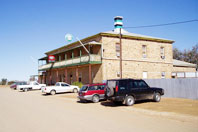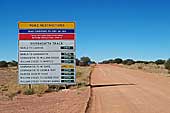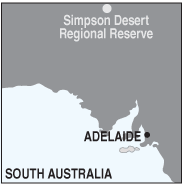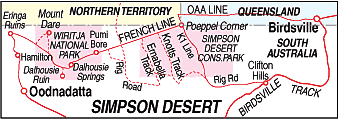
South Australia

Marree is rthe southern gateway to the Simpson Desert

Western turn-off to the Simpson Desert from Marla.

SIMPSON DESERT REGIONAL RESERVE: (2,919,680 Ha.)
This vast section of northern South Australia comes to life after seasonal rains when the red, rolling sand dunes bloom into a garden of brilliant colour. the best times to see this is in september or October.
A variety of small marsupials and reptiles will be seen and in good seasons, kangaroos and camels may be found.
this is normally very harsh country and 4WD and good preparation is essential.
SIMPSON DESERT TURNOFF:
11 km. south of Clifton Hills the turn-off to the K1 Line track over the Simpson Desert, which connects with Rig Road. (See Map) Another route leads across the north-west edge of Goyders Lagoon and on to Birdsville.
WARNING:
Do not attempt to use these routes unless equipped with 4WD vehicle, detailed maps and adequate supplies and preparation. A Desert Parks Permit is required if entering the Conservation Park or Regional Reserve.

SIMPSON DESERT CONSERVATION PARK (692,680Ha.)
Remote Outback Park with spectacular spectacular red dunes.
Access to the park is from Oodnadatta via the Dalhousie Springs, from Birdsville in Queensland via Poeppels Corner (the junction of the NT, SA and QLD borders), from Clifton Hills on the Birdsville Track or from the Northern Territory via Finke and Andado Station.
FACILITIES
There are no facilities in the park, howver 70 km. north of Dalhousie Spring the Mount Dare Station provides fuel, accommodation, camping, takeaway food, an hotel and emergency mechanical repairs. Mount Dare also has an airstrip. Telephone: 08 8670 7835. Hosts: Phil and Rhonda Hellyer.
ABOUT THE PARK
Located in the heart of the Simpson Desert in the far north of the state on the Northern Territory border, this park is mainly continuous red sand dunes with occasional mound springs, and plaka or salt lakes, and sprinklings of gidgee trees with scattered spinifex grass.
In Spring, or after heavy rains the park becomes a blanket of colour as wildflowers spring into life. These include yellow-tops, the Sturt Desert Pea and many paper type flowers which lie dormant in the sandy soil until water reaches them.
Many birds and marsupials will be found including budgerigars, zebra-finches, eyrean grass-wrens and Australian bustards or 'bush-turkeys'. Hopping mice, marsupial moles and many species of reptiles will also be found.
Access should be attempted only by 4WD vehicle and there are several tracks across the dunes. A good regional map is essential and provisions for several days should be carried when entering the park.
A Desert Parks Pass is required for camping, and there is little wood for fires in the area. Either bring your own, or use a fuel stove.
CROSSING THE SIMPSON DESERT
Birdsville to Oodnadatta
Crossing the Simpson Desert is becoming more and more popular as 4WD vehicles proliferate and there have been several successful crossing on foot. This journey is not however to be attempted by the normal bush-walker. The most notable of these are Warren Bonython and Charles McCubbin in 1973 and Denis Bartell in 1984.
Personal Note
Around 1975 I passed several camels and a calf born along the way, led by a Queensland man in overalls and prolific beard near Pimba on the Stuart Highway.
The camels wore garlands of Sturt Desert Peas around their necks and were making good time heading south.
There had been heavy rains in the area and the old dirt road had been badly cut about by semi-trailers churning their way through the mud. Eventually I slipped into a particularly deep rut und ripped much of my exhaust system out. Deciding to remove the remainder by hack-saw I climbed under to car to do the job and, while doing it, lost a set of keys. A membership badge from the Alice Springs Memorial Club was on the key ring and a couple of months later the manager of the club at the time, Cadge Gloede, came to my house to ask if I had lost some keys. This camel man had found the keys as he walked along the road and sent them to the club with a rather badly spelt note saying he had found them and had a family of 5 thirsty camels to feed, he was now back in Brisbane after doing his third crossing of the Desert, a walk he treated as a bit of a saunter. I sent him the customary 'Outback' currency, a carton of beer, for his thirsty brood and a letter of thanks.
Unfortunately it is so long ago now I have forgotten the name of the man. If he reads this... Thanks again !
To cross the desert you will need
Despite all this, the trip is a most rewarding challenge and one of the most spectacular remaining.
SIMPSON DESERT REGIONAL RESERVE 2,964,200Ha.
This regional reserve under the control of the National Parks and Wildlife Service is an extension of the Conservation Park and comprises most of the Simpson Desert. It is similar in terrain to main park.

